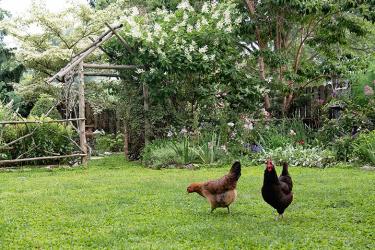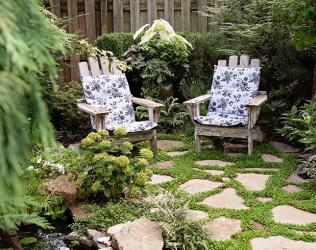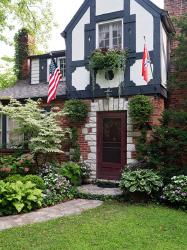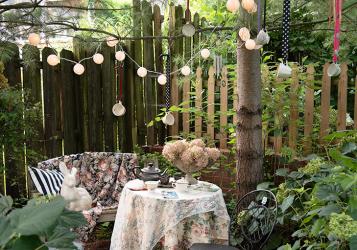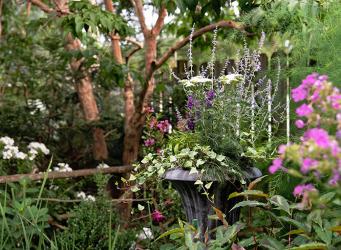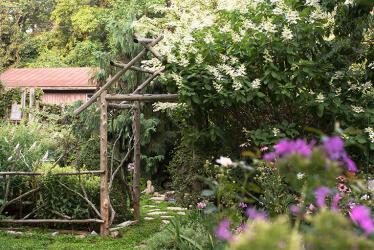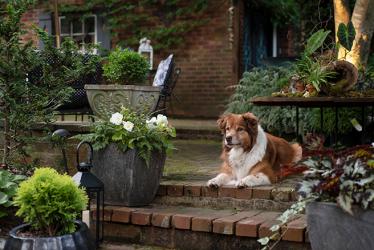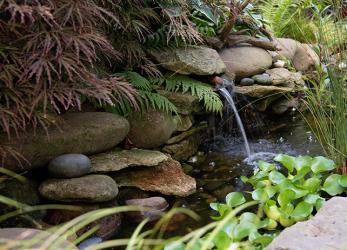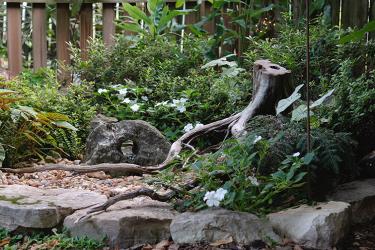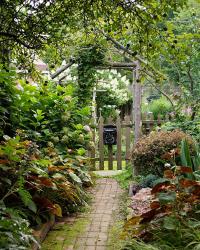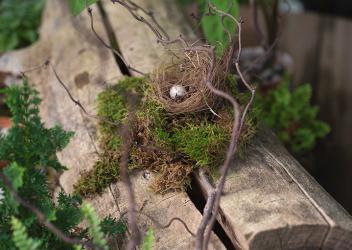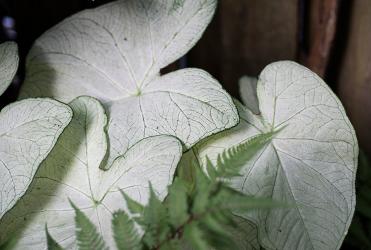Jo Batzer paints with plants. She draws with driftwood and sketches with saplings. One look at her garden and you see she is an artist. Colors, textures and shapes flow together and then play off each other.
A mélange of greens in a variety of textures welcomes visitors to her English Tudor home: the dark green, heart-shaped leaves of English ivy provide a carpet for chartreuse fans of mounded hosta. Backing the hosta, more structured, tiny leaved boxwoods lead to feathery stands of Japanese painted fern and maiden hair fern, flowing from the door-side urn. A delicate mix of white and lavender impatiens provides the only other color. White-edged hosta on one side of the front door is repeated in the creamy leaf margins of the variegated dogwood on the other side of the entrance.
In the back, a flowing rustic fence and arbor created by Jo and a friend from tree trunks and branches divides the space into sunny and shady areas. On one side of the arbor, the conical white blossoms of a tree-like Tardiva hydrangea arch over the arbor and seem to point toward the graceful, triangular wands of the white butterfly bush, mimicking a similar shape on the other.
The sculptural, free-form lines of water-washed driftwood, reclaimed from the shores of the Mississippi and Missouri Rivers, act as garden ornaments along fence lines and beside pathways.
Dangling from a tree branch, teacups suspended on ribbons and a string of tea lights decorate a quiet corner of the landscape. They leave no doubt about the purpose of the small, lace-covered refreshment table and chairs below.
In a clump of fern, a bird’s nest containing a pale blue egg is nestled on a bed of moss draped across an ancient silvery log. It is a detail that could have been plucked from a Dutch Master’s still life.
The blend of art and horticulture that is so evident in Jo’s garden had its roots early in her life. An honors art student in high school, she envisioned a career in commercial art, working in advertising or animation. Marriage and a move to a small town in Kansas diverted her into a job in the floral industry, which she immediately loved.
“I’ve always been drawn to anything that combines art with science,” she says. “Floral design incorporated my love of plants and design principles learned in college.” She ended up finishing her art degree with an emphasis on photography but on moving back to St. Louis, she decided “horticulture was my true calling.” She earned a second degree in horticulture from the well-known program at St. Louis Community College-Meramec.
Her talents were immediately snapped up by the Missouri Botanical Garden. During her 14 years at the garden in a variety of capacities, she worked on the side for private clients doing garden design and landscaping. Eventually, her landscaping business became so successful, she left the Botanical Garden to work full-time at her own business JB Designs. She also continued to work part-time in the off season in the floral design industry for Ambius, a company specializing in commercial interior landscaping and holiday decorating services.
If that weren’t enough, during the pandemic when public gardens closed and private garden tours were non-existent, she founded Garden-Lou.com, a website dedicated to all things gardening in the Greater St. Louis area.
With her talent spread wide, it is in her own garden in Spanish Lake that she has put down her deepest roots. Her English country landscape, which she began from scratch in 1995, reflects the Tudor architecture of her home. “I have been in love with England and Scotland ever since I realized those places really existed and were not just something I read about in story books,” she says. Those childhood pictures are recreated just three minutes from I-270. Mulch softens log-lined pathways. A carpet of the groundcover mazus reptans, interspersed with stepping stones, provides an open lawn for strolling chickens that seem to have stepped out of a Beatrix Potter sketch book. Small, bubbling water features make a charming addition to garden beds.
She treasures a comment from one of the first visitors to her garden as part of a Spanish Lake garden tour. “She was a little old English lady, and she told me that she felt like she was back in England,” Jo recalls. “I was just overwhelmed.”
While her garden features numerous perennials and shrubs, Jo describes herself as a huge tree geek, beginning with two black gum trees she planted shortly after moving in. Many of her trees have sentiment attached. There is the ginkgo she grafted as part of a class at Meramec. “A yellow wood a friend at the Botanical Garden gave to me that was 2 feet high and a scrawny little thing when I planted it. A golden larch tree which is a descendent of a beloved friend's tree. A white pine my stepson brought home from grade school as part of Arbor Day. If I could get more trees onto this piece of property, I would. I recently switched to dwarf conifers,” she says with a laugh. “It’s a little like wine, first you like the sweet stuff, then you get into the dry reds.”
The reason for her love of trees: “When I look out of the house in the winter, I don’t want to see bare nothingness. I want to see form and structure and texture. I am a huge texture freak. I love things like peely bark.”
Even in the summer, she relies on texture, shades of green and variegated plants with shots of white. “This is where I come to relax,” she says of her own garden. “I am out dealing with people and their gardens all day. I don’t want to be in your face with color when I come home. I use lots of white and then maybe purples and pinks”
She also uses her own garden as a living lab to try new varieties. “How many plants have we all killed?” she asks rhetorically. “I like to do that in my own yard, not a clients’ yard.”
She draws a distinction between landscaping and “a true garden for intent and sentiment. Sentiment is one of the things that makes a true garden,” she says. “I still have the purple flag iris that came from one aunt and the sedum that came from another. I can’t look anywhere in this garden and not see an old friend or a place we have traveled. I can get another dogwood, but it won’t be the one my friend grafted for me.”


